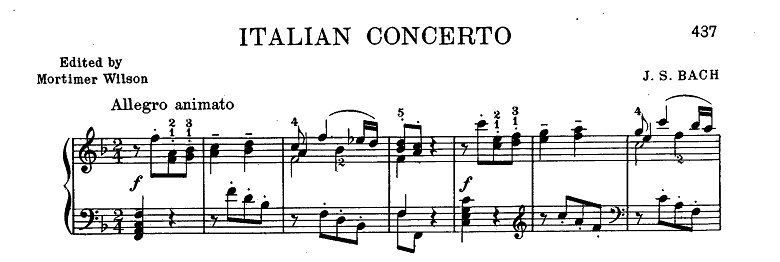
I played Bach’s “Italian Concerto, First Movement” when I was a teenager, and even now, playing it again, I can say it’s one of my favorite pieces by Bach!
It’s enjoyable to play, but also delightful to listen to.
For me, especially the first movement—once I start listening, I can’t help but listen all the way to the end. Even though I know what’s coming next, I find myself drawn to listen again and again. It’s that kind of piece.
As an adult, I’ve realized how little time I have to just sit and listen to music these days.
And just as I thought I’d smoothly write my way through this blog post, somehow, somehow…
a series of questions kept popping into my mind (+o+).
Let’s start with the first question.
Contents
- 1 Why Does the Title Include “Italian”??
- 2 Why Is It Called the “Italian Concerto” If It’s Played Solo?
- 3 What is the Difficulty Level of the “Italian Concerto, First Movement”?
- 4 Playing Bach Is Profoundly Deep…
- 5 Why Does the Atmosphere Change Depending on the Performer?
- 6 Choosing the Right Score Is Also Important!
- 7 Summary
Why Does the Title Include “Italian”??
The “Italian Concerto” was published in 1735 by Johann Sebastian Bach under its original title, Concerto in the Italian Style, BWV 971. It was released alongside French Overture, BWV 831, as part of Clavier-Übung II.By the way, the “Italian Concerto” is structured in three movements.
Now that we’ve covered that, why exactly does the title include “Italian”?
After doing some research, it seems that in the 17th and 18th centuries, during Bach’s time, Italy was at the forefront of the arts in Europe. It was essentially the trendsetting country of its era!
Though Bach never left Germany during his lifetime, it seems he had a fascination and admiration for Italian music.
In fact, it’s said that the concerto form itself originated in Italy. Considering these factors, it’s believed that this “Italian Concerto” was created to reflect that influence.
Having figured out why the title includes “Italian,” another question popped into my mind (?_?).
Why Is It Called the “Italian Concerto” If It’s Played Solo?
A concerto is typically a genre where a solo instrument performs alongside an orchestra. So technically, the “Italian Concerto” should involve a group performance (+o+).So, I looked into this.
It appears that when Bach was employed by a nobleman, he was asked to adapt music by Italian composers such as Vivaldi into something playable on the harpsichord.
Eventually, Bach composed this piece using his own original melodies.
As many of you might already know, during Bach’s era, the modern piano we know today didn’t exist yet. The primary keyboard instrument was the harpsichord (also known as a clavecin).
Now, please take a moment to listen to the harpsichord performance of the original version!
The performance starts at 1:30.
What is the Difficulty Level of the “Italian Concerto, First Movement”?
According to the difficulty ranking by Zen-On Piano Pieces, it’s listed as E level. This places it on the same level as Chopin’s Fantaisie-Impromptu, his Nocturnes, and Liszt’s Liebesträume.For most people progressing through Bach’s repertoire, they typically start with Inventions, move on to Sinfonias, and then encounter Das Wohltemperierte Klavier, where they might come across this piece.
Considering the control required for each note, I guess that’s why it’s rated E?
Categorizing difficulty levels is tricky, isn’t it (+o+).
Playing Bach Is Profoundly Deep…

Alright, let’s finally get into how to play it.
To be honest, while writing this article, I was quite conflicted about what perspective to take.
Why? Well, it’s because there are countless materials on Bach’s musical analysis (+o+).
That’s right—there are probably people far more qualified than I am to explain this. You can find plenty of resources in books and online, so if you’re interested, definitely check those out too!
So, where am I aiming to go with this article?
Right here (Can you guess where that is?)… Well, I’ll get there eventually (laughs).
Why Does the Atmosphere Change Depending on the Performer?
First, please listen and compare the two performances.◆First Performance
◆Second Performance
Which performance do you prefer?
The first one resembles an orchestral performance, while the second one evokes the sound of a harpsichord.
Even the way the first chord is played differs. The first performance uses an arpeggio for a more brilliant effect, while the second performance plays the four notes simultaneously.
*For those who want to check the score, it is included later in this article for reference.
There is no definitive “correct” way to play it. The performer’s interpretation can transform the world of the first movement of the Italian Concerto.
I think this is where Bach’s charm lies. Even with the same melody, the phrasing can change depending on how it is interpreted (*^_^*).
When I was in middle school, lessons tended to emphasize an originalist interpretation (though this might vary by region or school of thought—apologies if this wasn’t your experience (>_<)). I recall lessons where we were taught to aim for a sound resembling the harpsichord of Bach’s era.
These days, we hear a wider variety of performances, including those that make the most of the modern piano.
Choosing the Right Score Is Also Important!
Actually, Bach’s sheet music can generally be divided into two types, even for the same piece.The first type is the so-called “Urtext edition,” which closely resembles the music Bach composed at the time.
The second type is the “edited edition,” which includes additional slurs and fingerings added by editors to make it easier to play on modern pianos.
① Urtext Edition (understood as having minimal added musical notation)

② Edited Edition

In particular, the fingerings differ depending on the editor. When purchasing sheet music, it can be helpful to ask your piano teacher which score to use.
The first score you use might significantly influence your future playing.
Please keep this in mind when making your choice♪
Summary
1. Bach’s music allows for a variety of interpretative approaches.2. Choosing the right sheet music for practice is unexpectedly important.
This applies not only to this piece but also to other works by Bach.
I hope you can create your unique interpretation of the Italian Concerto.
I’m cheering for you to play it beautifully♪
- IMSLP (Score Link)
This is the public domain score introduced as the Urtext edition in this article, published by Breitkopf & Härtel in 1853. - IMSLP (Score Link)
This is the public domain score introduced as the edited edition in this article, published by University Society in 1918.
- J.S. Bach "Goldberg Variations" Masterpiece! The Charm of Historical Harpsichords and the Beauty of the Melody 2017/7/9
- How to Master Bach’s ‘Italian Concerto, First Movement’: Difficulty Level Explained! 2018/9/5 ←Currently Viewing Article
- Difficulty Level and Tips for Playing Bach’s “Italian Concerto, Third Movement” 2018/11/22










